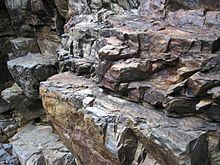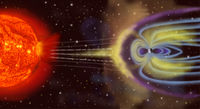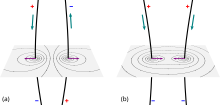Earth Science Guided Reading and Study Workbook Chapter 25 Answers
All fields of natural science related to Earth.

The rocky side of a mountain creek near Orosí, Costa Rica. (presumably metamorphic rocks)
Earth science or geoscience includes all fields of natural science related to planet Earth. This is a branch of science dealing with the physical and chemical constitution of Earth and its atmosphere. Earth science can be considered to be a branch of planetary science, but with a much older history. Earth science encompasses four main branches of study, the lithosphere, the hydrosphere, the atmosphere, and the biosphere, each of which is further broken down into more specialized fields.
There are both reductionist and holistic approaches to Earth sciences. It is also the study of Earth and its neighbors in space. Some Earth scientists use their knowledge of the planet to locate and develop energy and mineral resources. Others study the impact of human activity on Earth's environment, and design methods to protect the planet. Some use their knowledge about Earth processes such as volcanoes, earthquakes, and hurricanes to plan communities that will not expose people to these dangerous events.
Earth sciences can include the study of geology, the lithosphere, and the large-scale structure of Earth's interior, as well as the atmosphere, hydrosphere, and biosphere. Typically, Earth scientists use tools from geology, chronology, physics, chemistry, geography, biology, and mathematics to build a quantitative understanding of how Earth works and evolves. Earth science affects our everyday lives. For example, meteorologists study the weather and watch for dangerous storms. Hydrologists examine water and warn of floods. Seismologists study earthquakes and try to understand where they will strike. Geologists study rocks and help to locate useful minerals. Earth scientists often work in the field—perhaps climbing mountains, exploring the seabed, crawling through caves, or wading in swamps. They measure and collect samples (such as rocks or river water), then record their findings on charts and maps.
Fields of study [edit]
The following fields of science are generally categorized within the Earth sciences:
- Geology describes the rocky parts of the Earth's crust (or lithosphere) and its historic development. Major subdisciplines are mineralogy and petrology, geomorphology, paleontology, stratigraphy, structural geology, engineering geology, and sedimentology.[1] [2]
- Physical geography focuses on geography as an Earth science. Physical geography is the study of Earth's seasons, climate, atmosphere, soil, streams, landforms, and oceans. Physical geography can be divided into several branches or related fields, as follows: geomorphology, biogeography, environmental geography, palaeogeography, climatology, meteorology, coastal geography, hydrology, ecology, glaciology.[ citation needed ]
- Geophysics and geodesy investigate the shape of the Earth, its reaction to forces and its magnetic and gravity fields. Geophysicists explore the Earth's core and mantle as well as the tectonic and seismic activity of the lithosphere.[2] [3] [4] Geophysics is commonly used to supplement the work of geologists in developing a comprehensive understanding of crustal geology, particularly in mineral and petroleum exploration. Seismologists use geophysics to understand plate tectonic shifting, as well as predict seismic activity.
- Geochemistry is defined as the study of the processes that control the abundance, composition, and distribution of chemical compounds and isotopes in geologic environments. Geochemists use the tools and principles of chemistry to study the composition, structure, processes, and other physical aspects of the Earth. Major subdisciplines are aqueous geochemistry, cosmochemistry, isotope geochemistry and biogeochemistry.
- Soil science covers the outermost layer of the Earth's crust that is subject to soil formation processes (or pedosphere).[5] Major subdivisions in this field of study include edaphology and pedology.[6]
- Ecology covers the interactions between organisms and their environment. This field of study differentiates the study of Earth from the study of other planets in the Solar System, Earth being its only planet teeming with life.
- Hydrology, oceanography and limnology are studies which focus on the movement, distribution, and quality of the water and involves all the components of the hydrologic cycle on the Earth and its atmosphere (or hydrosphere). "Sub-disciplines of hydrology include hydrometeorology, surface water hydrology, hydrogeology, watershed science, forest hydrology, and water chemistry."[7]
- Glaciology covers the icy parts of the Earth (or cryosphere).
- Atmospheric sciences cover the gaseous parts of the Earth (or atmosphere) between the surface and the exosphere (about 1000 km). Major subdisciplines include meteorology, climatology, atmospheric chemistry, and atmospheric physics.
Earth's interior [edit]

A volcanic eruption is the release of stored energy from below Earth's surface.[8]
Plate tectonics, mountain ranges, volcanoes, and earthquakes are geological phenomena that can be explained in terms of physical and chemical processes in the Earth's crust.[9]
Beneath the Earth's crust lies the mantle which is heated by the radioactive decay of heavy elements. The mantle is not quite solid and consists of magma which is in a state of semi-perpetual convection. This convection process causes the lithospheric plates to move, albeit slowly. The resulting process is known as plate tectonics.[10] [11] [12] [13]
Plate tectonics might be thought of as the process by which the Earth is resurfaced. As the result of seafloor spreading, new crust and lithosphere is created by the flow of magma from the mantle to the near surface, through fissures, where it cools and solidifies. Through subduction, oceanic crust and lithosphere returns to the convecting mantle.[11] [13] [14]
Areas of the crust where new crust is created are called divergent boundaries, those where it is brought back into the Earth are convergent boundaries and those where plates slide past each other, but no new lithospheric material is created or destroyed, are referred to as transform (or conservative) boundaries[11] [13] [15] Earthquakes result from the movement of the lithospheric plates, and they often occur near convergent boundaries where parts of the crust are forced into the earth as part of subduction.[16]
Volcanoes result primarily from the melting of subducted crust material. Crust material that is forced into the asthenosphere melts, and some portion of the melted material becomes light enough to rise to the surface—giving birth to volcanoes.[11] [16]
Earth's atmosphere [edit]

The troposphere, stratosphere, mesosphere, thermosphere, and exosphere are the five layers which make up Earth's atmosphere. 75% of the gases in the atmosphere are located within the troposphere, the lowest layer. In all, the atmosphere is made up of about 78.0% nitrogen, 20.9% oxygen, and 0.92% argon. In addition to the nitrogen, oxygen, and argon there are small amounts of other gases including CO2 and water vapor.[17] Water vapor and CO2 allow the Earth's atmosphere to catch and hold the Sun's energy through a phenomenon called the greenhouse effect.[18] This allows Earth's surface to be warm enough to have liquid water and support life. In addition to storing heat, the atmosphere also protects living organisms by shielding the Earth's surface from cosmic rays—which are often incorrectly thought to be deflected by the magnetic field.[19] The magnetic field—created by the internal motions of the core—produces the magnetosphere which protects Earth's atmosphere from the solar wind.[20] As the Earth is 4.5 billion years old,[21] it would have lost its atmosphere by now if there were no protective magnetosphere.
Earth's magnetic field [edit]
An electromagnet is a magnet that is created by an electric current.[22] The Earth has a solid iron inner core surrounded by a fluid outer core that convects;[23] therefore, Earth is an electromagnet. The motion of fluid convection sustains the Earth's magnetic field.[23] [24]
The magnetic field is also very important since some birds and insects use the field to navigate over long distances. They are able to do so by the magnetized iron crystals found in their skin for orientation. The most important function of Earth's magnetic field is protecting it's organisms. High energy protons are deflected along with electrons in the solar wind. If organisms have direct exposure to these particles it would be lethal.[25] For the consistency of a magnetic field to remain constant there must be an attractive magnetic field. If the motion of a magnetic field changes then every aspect of it does as well. It indicates a force that is proportional to the velocity of a moving charge[26]
Magnetic Fields can be measured with many different units like Tesla (T). another commonly used unit is the Gauss (G) or me 1 G is equivalent to 10-4 T (or 1 mG = 0.1µT) Smaller magnetic field unit is the Gauss (1 Tesla = 10,000 Gauss)[27]

In the image above the first example their Anti-parallel currents with cause them to repel. In the second example they are parallel currents which cause attraction.
The Lorentz Force Law [edit]
Everything within the magnetic field can be defined by the Lorentz Law.
The electromagnetic force holds atoms and molecules together. In fact, the forces of electric attraction and repulsion of electric charges are so dominant over the other three fundamental forces that they can be considered to be negligible as determiners of atomic and molecular structure[28]
The Lorentz Force Law was names after Dutch physicist, Hendrik Antoon Lorentz he was the first to formulate this equation. Lorentz theorized that atoms might consist of charged particles and suggested that the oscillations of these charged particles were the source of light.[29]

Changing magnetic field through a coil of wire therefore must induce an EMF the coil which in turn causes current to flow.[30]
Methodology [edit]
Methodologies vary depending on the nature of the subjects being studied. Studies typically fall into one of three categories: observational, experimental, or theoretical. Earth scientists often conduct sophisticated computer analysis or visit an interesting location to study earth phenomena (e.g. Antarctica or hot spot island chains).
A foundational idea in Earth science is the notion of uniformitarianism, which states that "ancient geologic features are interpreted by understanding active processes that are readily observed."[ citation needed ] In other words, any geologic processes at work in the present have operated in the same ways throughout geologic time. This enables those who study Earth's history to apply knowledge of how Earth processes operate in the present to gain insight into how the planet has evolved and changed throughout long history.
Earth's spheres [edit]
Earth science generally recognizes four spheres, the lithosphere, the hydrosphere, the atmosphere, and the biosphere;[31] these correspond to rocks, water, air and life. Also included by some are the cryosphere (corresponding to ice) as a distinct portion of the hydrosphere and the pedosphere (corresponding to soil) as an active and intermixed sphere.
Earth science breakup [edit]
- Atmosphere
- Atmospheric chemistry
- Geography
- Climatology
- Meteorology
- Hydrometeorology
- Paleoclimatology
- Biosphere
- Biogeochemistry
- Biogeography
- Ecology
- Landscape ecology
- Geoarchaeology
- Geomicrobiology
- Paleontology
- Palynology
- Micropaleontology
- Hydrosphere
- Hydrology
- Hydrogeology
- Limnology (freshwater science)
- Oceanography (marine science)
- Chemical oceanography
- Physical oceanography
- Biological oceanography (marine biology)
- Geological oceanography (marine geology)
- Paleoceanography
- Lithosphere (geosphere)
- Geology
- Economic geology
- Engineering geology
- Environmental geology
- Historical geology
- Quaternary geology
- Planetary geology and planetary geography
- Sedimentology
- Stratigraphy
- Structural geology
- Geography
- Human geography
- Physical geography
- Geochemistry
- Geomorphology
- Geophysics
- Geochronology
- Geodynamics (see also Tectonics)
- Geomagnetism
- Gravimetry (also part of Geodesy)
- Seismology
- Glaciology
- Hydrogeology
- Mineralogy
- Crystallography
- Gemology
- Petrology
- Petrophysics
- Speleology
- Volcanology
- Pedosphere
- Geography
- Soil science
- Edaphology
- Pedology
- Systems
- Earth system science
- Environmental science
- Geography
- Human geography
- Physical geography
- Gaia hypothesis
- Systems ecology
- Systems geology
- Others
- Geography
- Cartography
- Geoinformatics (GIScience)
- Geostatistics
- Geodesy and Surveying
- Remote Sensing
See also [edit]
- American Geosciences Institute
- Earth sciences graphics software
- Environmental geoscience
- GEO-LEO (GEO Library Experts Online)
- Glossary of geology terms
- List of geoscience organizations
- List of Russian Earth scientists
- List of unsolved problems in geoscience
- Making North America (2015 PBS film)
- Nanogeoscience
- National Association of Geoscience Teachers
- Science tourism
- Structure of the Earth
References [edit]
- ^ Adams & Lambert 2006, p. 20
- ^ a b Smith & Pun 2006, p. 5
- ^ "WordNet Search – 3.1". princeton.edu.
- ^ "NOAA National Ocean Service Education: Global Positioning Tutorial". noaa.gov.
- ^ Elissa Levine, 2001, The Pedosphere As A Hub broken link?
- ^ Gardiner, Duane T. "Lecture 1 Chapter 1 Why Study Soils?". ENV320: Soil Science Lecture Notes. Texas A&M University-Kingsville. Archived from the original on 2018-02-09. Retrieved 2019-01-07 .
- ^ Craig, Kendall. "Hydrology of the Watershed".
- ^ Encyclopedia of Volcanoes, Academic Press, London, 2000
- ^ "Earth's Energy Budget". ou.edu.
- ^ Simison 2007, paragraph 7
- ^ a b c d Adams & Lambert 2006, pp. 94–95, 100, 102
- ^ Smith & Pun 2006, pp. 13–17, 218, G-6
- ^ a b c Oldroyd 2006, pp. 101, 103, 104
- ^ Smith & Pun 2006, p. 327
- ^ Smith & Pun 2006, p. 331
- ^ a b Smith & Pun 2006, pp. 325–26, 329
- ^ Adams & Lambert 2006, pp. 107–08
- ^ American Heritage, p. 770
- ^ Parker, Eugene (March 2006), Shielding Space (PDF), Scientific American
- ^ Adams & Lambert 2006, pp. 21–22
- ^ Smith & Pun 2006, p. 183
- ^ American Heritage, p. 576
- ^ a b Oldroyd 2006, p. 160
- ^ Demorest, Paul (2001-05-21). "Dynamo Theory and Earth's Magnetic Field" (PDF). Archived from the original (PDF) on February 21, 2007. Retrieved 2007-11-17 .
- ^ Christensen, Norman L. (2019). The Environment and you. Lissa Leege, Justin St. Juliana (Third ed.). NY, NY. ISBN978-0-13-464605-3. OCLC 1007498917.
- ^ Hughes, Scott (10 March 2005). "Massachusetts Institute of Technology Department of Physics 8.022 Spring 2004 Lecture 10: Magnetic force; Magnetic fields; Ampere's law" (PDF).
- ^ e5605c6d2607f5b521c46cdf7a23082c (2017-04-26). "Measuring magnetic fields". ARPANSA . Retrieved 2021-05-18 .
- ^ "Fundamental Forces". hyperphysics.phy-astr.gsu.edu . Retrieved 2021-05-18 .
- ^ "The Nobel Prize in Physics 1902". NobelPrize.org . Retrieved 2021-05-18 .
- ^ "Introduction to Magnetism and Induced Currents". www.rpi.edu . Retrieved 2021-05-18 .
- ^ Earth's Spheres Archived August 31, 2007, at the Wayback Machine. ©1997–2000. Wheeling Jesuit University/NASA Classroom of the Future. Retrieved November 11, 2007.
Sources [edit]
- Adams, Simon; Lambert, David (2006). Earth Science: An illustrated guide to science. New York, NY: Chelsea House. ISBN978-0-8160-6164-8.
- Joseph P. Pickett (executive editor) (1992). American Heritage dictionary of the English language (4th ed.). Boston, MA: Houghton Mifflin Company. ISBN978-0-395-82517-4.
- Simison, W. Brian (2007-02-05). "The mechanism behind plate tectonics". Retrieved 2007-11-17 .
- Smith, Gary A.; Pun, Aurora (2006). How Does the Earth Work? Physical Geology and the Process of Science. Upper Saddle River, NJ: Pearson Prentice Hall. ISBN978-0-13-034129-7.
- Oldroyd, David (2006). Earth Cycles: A historical perspective. Westport, CT: Greenwood Press. ISBN978-0-313-33229-6.
Further reading [edit]
- Allaby M., 2008. Dictionary of Earth Sciences, Oxford University Press, ISBN 978-0-19-921194-4
- Korvin G., 1998. Fractal Models in the Earth Sciences, Elsvier, ISBN 978-0-444-88907-2
- "Earth's Energy Budget". Oklahoma Climatological Survey. 1996–2004. Retrieved 2007-11-17 .
- Miller, George A.; Christiane Fellbaum; and Randee Tengi; and Pamela Wakefield; and Rajesh Poddar; and Helen Langone; Benjamin Haskell (2006). "WordNet Search 3.0". WordNet a lexical database for the English language. Princeton, NJ: Princeton University/Cognitive Science Laboratory. Retrieved 2007-11-10 .
- "NOAA National Ocean Service Education: Geodesy". National Oceanic and Atmospheric Administration. 2005-03-08. Retrieved 2007-11-17 .
- Reed, Christina (2008). Earth Science: Decade by Decade. New York, NY: Facts on File. ISBN978-0-8160-5533-3.
- Tarbuck E. J., Lutgens F. K., and Tasa D., 2002. Earth Science, Prentice Hall, ISBN 978-0-13-035390-0
External links [edit]
- Earth Science Picture of the Day, a service of Universities Space Research Association, sponsored by NASA Goddard Space Flight Center.
- Geoethics in Planetary and Space Exploration.
- Geology Buzz: Earth Science
Earth Science Guided Reading and Study Workbook Chapter 25 Answers
Source: https://en.wikipedia.org/wiki/Earth_science

0 Response to "Earth Science Guided Reading and Study Workbook Chapter 25 Answers"
Post a Comment